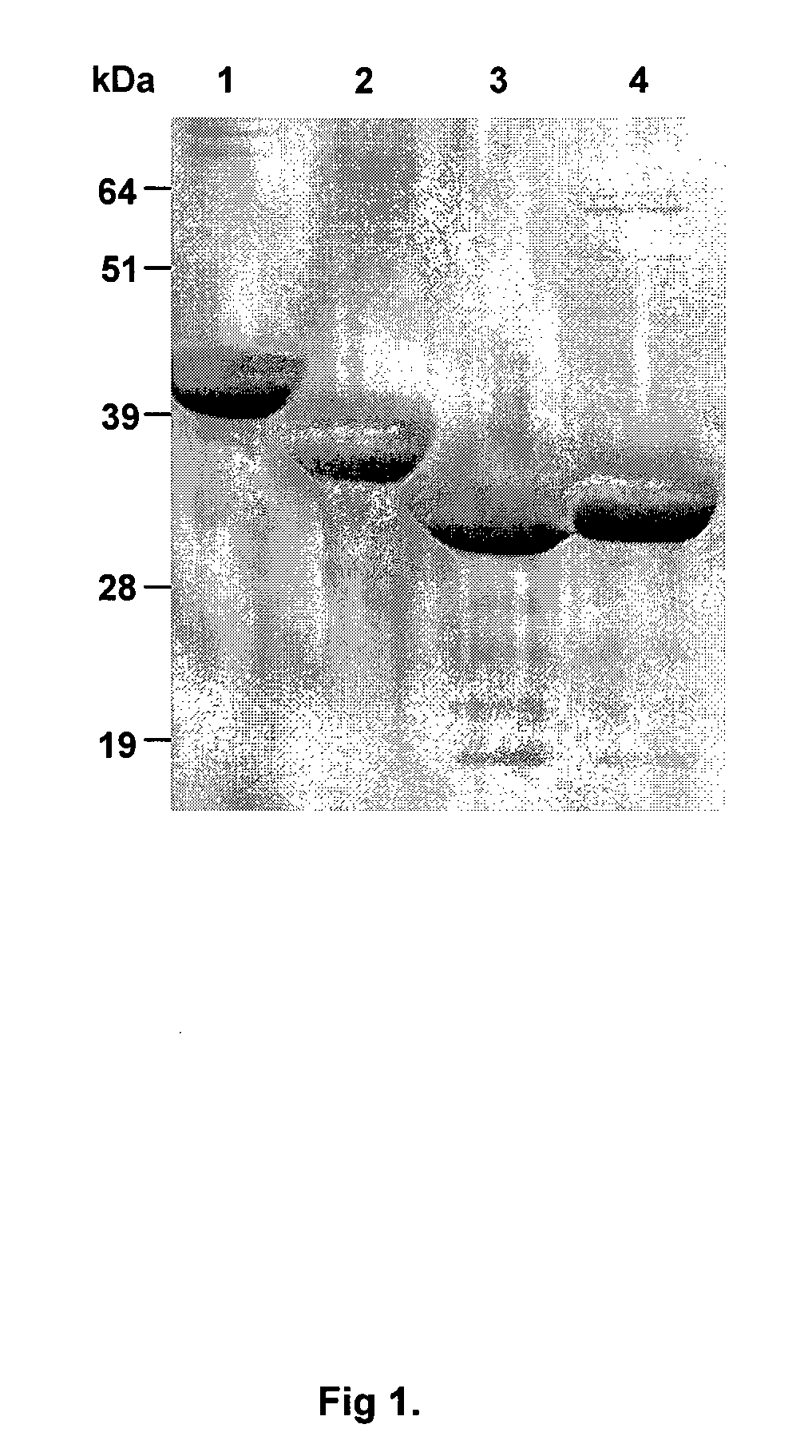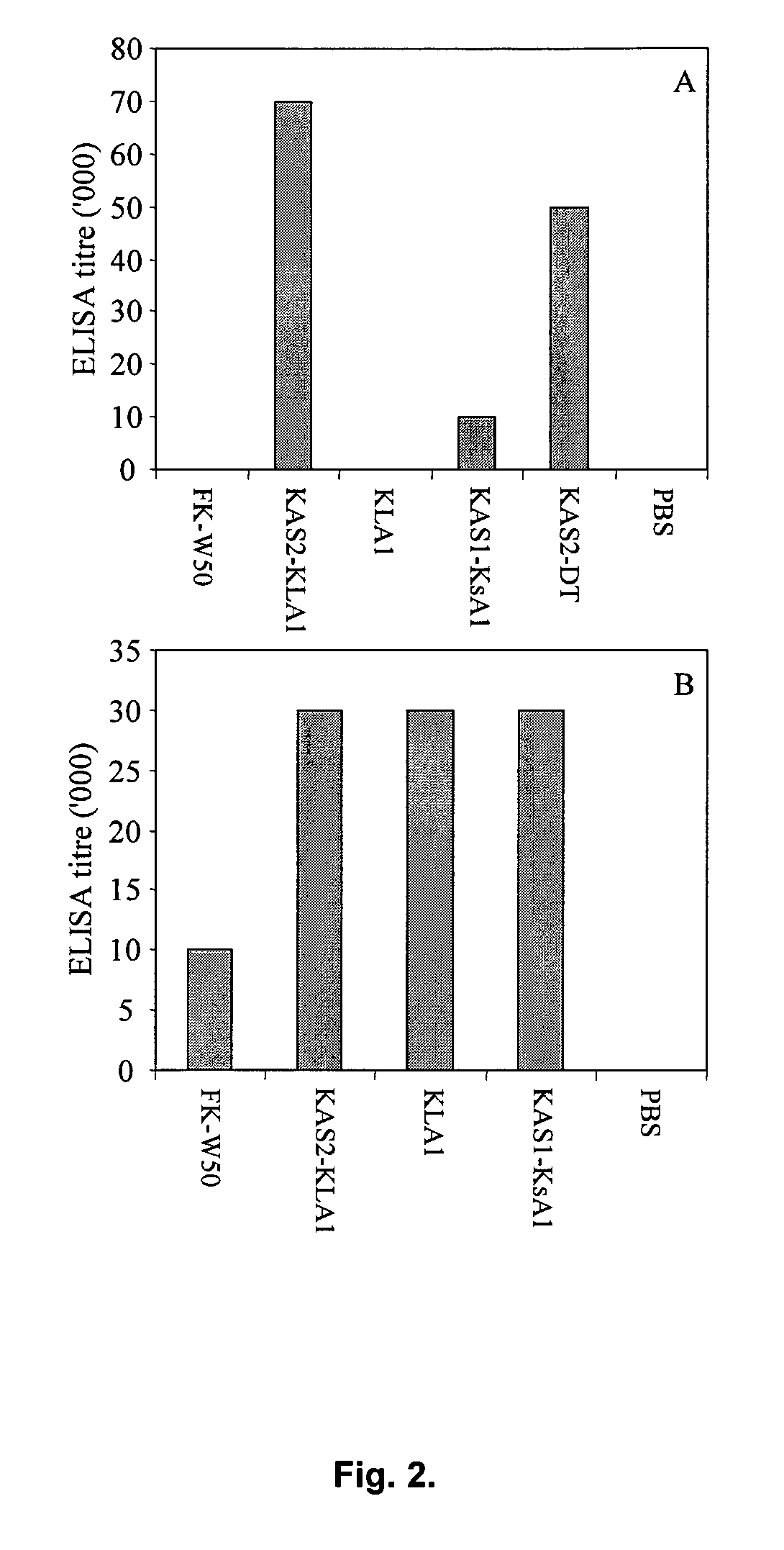Treatment or prevention of infection
a technology for treating or preventing infections, applied in the field of treating or preventing diseases or conditions, can solve the problems of resorption of alveolar bone, eventual tooth loss, and lack of clear protective response, and achieve the effect of reducing the incidence or severity of a diseas
- Summary
- Abstract
- Description
- Claims
- Application Information
AI Technical Summary
Benefits of technology
Problems solved by technology
Method used
Image
Examples
example 1
Methods and Materials
[0259]Bacterial Strains and Growth Conditions.
[0260]Lyophilised cultures of Porphyromonas gingivalis W50 were grown anaerobically at 37° C. on lysed horse blood agar plates supplemented with 5 μg / ml haemin, 0.5 μg / ml cysteine (HB agar, 2, and 5 mM cysteine-HCl, pH 8.0) in the anaerobic workstation. Growth of batch cultures was monitored at 650 nm using a spectrophotometer (model 295E, Perkin-Elmer). Culture purity was checked routinely by Gram stain, microscopic examination and using a variety of biochemical tests according to Slots (2).
[0261]Construction of pET28 Constructs Containing Adhesin Sequences and Adhesin Sequences with N-Terminal Addition of Kgp Proteinase Sequences.
[0262]Kgp residues representing peptides and chimeric peptides of the active site (AS) and KgpA1 adhesin (A1) domains were over-expressed in E. coli as recombinant (r) proteins with hexa-His tags (SEQ ID NO: 93) using pET expression vectors (Novagen). The r-proteins expressed were rKAS2, a...
example 2
Characterisation and Purification of the Recombinant Proteins (KSA1, KLA1, KAS1-KsA1 and KAS2-KLA1)
[0285]In order to characterise the ability of Kgp adhesin A1 domain fragments and chimera Kgp proteinase and Kgp adhesin A1 domain fragments to protect against P. gingivalis infection, we expressed and purified the recombinant proteins:—KsA1, KLA1, KAS1-KsA1 and KAS2-KLA1. Recombinant proteins (KsA1 and KLA1) and recombinant chimera proteins (KAS1-KsA1 and KAS2-KLA1) were purified from inclusion bodies using nickel chelate affinity chromatography and the purified proteins analysed by SDS-PAGE (FIG. 1). Each of the purified recombinant proteins consisted of one major protein band with molecular weights of 40, 36, 31 and 32 kDa corresponding to KAS2-KLA1, KLA1, KsA1 and KAS1-KsA1, and these weights corresponded to the calculated molecular masses of the His-tag recombinant proteins using ProtParam. To characterize the immunogenicity of the recombinant proteins KsA1, KLA1, KAS1-KsA1 and KA...
example 3
Effect of Immunization with the Recombinant Proteins (KSA1, KLA1, KAS1-KSA1 and KAS2-KLA1) on P. gingivalis Induced Alveolar Bone Loss in the Mouse Periodontitis Model
[0286]The recombinant proteins KsA1, KLA1, KAS1-KsA1 and KAS2-KLA1, formalin killed P. gingivalis strain W50 and the RgpA-Kgp complex were used to determine and compare the protection induced against P. gingivalis induced alveolar bone loss using a modified mouse model of periodontal bone loss based on that reported by Baker et al (4). Mice were immunized (days 0 and 30) with either recombinant proteins KsA1, KLA1, KAS1-KsA1 or KAS2-KLA1, RgpA-Kgp complex or formalin killed P. gingivalis strain W50 (FK-W50) cells or PBS adjuvant alone and were then orally challenged with viable P. gingivalis W50. Immunization with all of the recombinant antigens, RgpA-Kgp complex and FK-W50 cells protected BALB / c mice against P. gingivalis-induced alveolar bone loss as these animals exhibited significantly (p<0.001) less bone loss comp...
PUM
| Property | Measurement | Unit |
|---|---|---|
| temperatures | aaaaa | aaaaa |
| mass | aaaaa | aaaaa |
| density | aaaaa | aaaaa |
Abstract
Description
Claims
Application Information
 Login to View More
Login to View More - R&D
- Intellectual Property
- Life Sciences
- Materials
- Tech Scout
- Unparalleled Data Quality
- Higher Quality Content
- 60% Fewer Hallucinations
Browse by: Latest US Patents, China's latest patents, Technical Efficacy Thesaurus, Application Domain, Technology Topic, Popular Technical Reports.
© 2025 PatSnap. All rights reserved.Legal|Privacy policy|Modern Slavery Act Transparency Statement|Sitemap|About US| Contact US: help@patsnap.com



